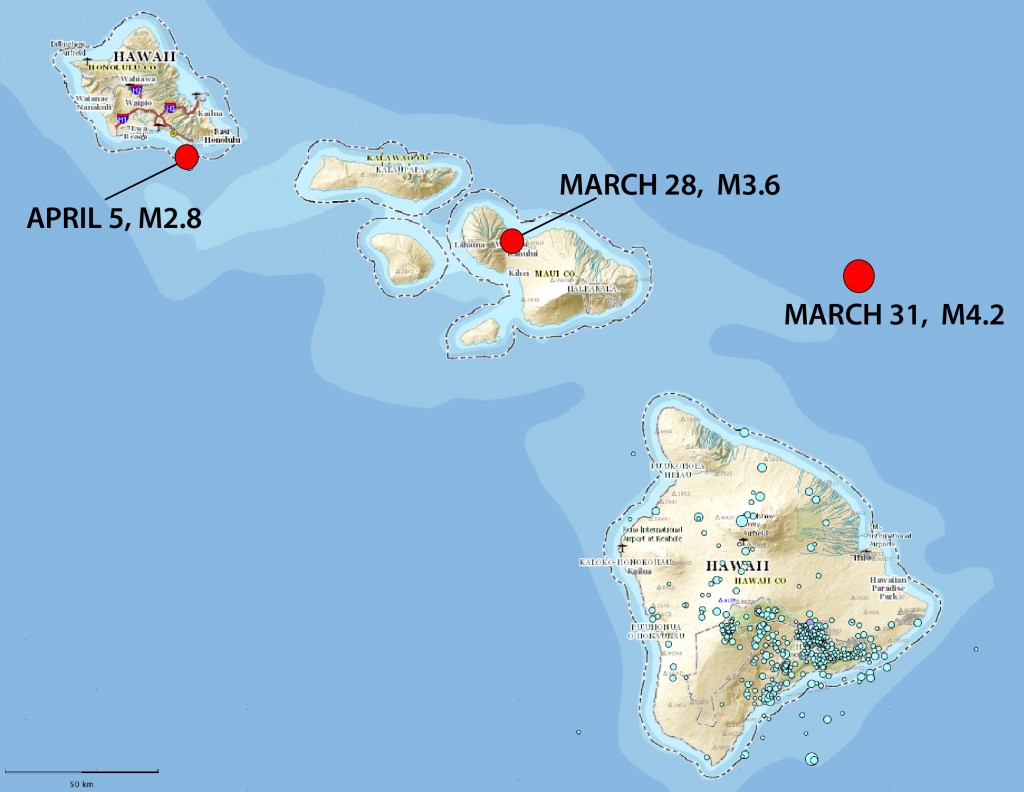Three Neighbor Island Quakes Offer Gentle Reminder
 While Hawai‘i County residents likely feel dozens of earthquakes each year, residents across the state were gently reminded that they, too, live with the threat. The reminder came as three small quakes nudged the outer islands between March 28 and April 5, 2016.
While Hawai‘i County residents likely feel dozens of earthquakes each year, residents across the state were gently reminded that they, too, live with the threat. The reminder came as three small quakes nudged the outer islands between March 28 and April 5, 2016.
- 3.6M Earthquake (March 28, 2016): Early morning on Monday, March 28, 2016, a magnitude-3.6 earthquake struck beneath the isthmus connecting West and East Maui.
- 4.2M Earthquake (March 31, 2016): Four days later, late on the night of Thursday, March 31, a M4.2 earthquake, centered roughly 55 miles east of Hāna, Maui, was felt across the state.
- 2.8M Earthquake (April 5, 2016): Three days later, on the morning of Tuesday, April 5, a M2.8 earthquake, centered about 3 miles off Diamond Head, shook parts of Honolulu.
While all three quakes were considered “small,” they were large enough that people felt them and submitted reports at the US Geological Survey’s “Did You Feel It?” webpage.
The recent Maui and O‘ahu earthquakes—recorded State-wide by seismographic networks of the USGS Hawaiian Volcano Observatory and NOAA Pacific Tsunami Warning Center—were all located at depths between about 11 and 22 miles.
“At such depths, and away from centers of volcanic activity, such as Kīlauea or Mauna Loa on Hawai‘i Island, the flexing, or bending, of the Earth’s lithosphere (the crust and uppermost rigid layer of the mantle) due to the weight of the islands produces forces that result in occasional earthquakes,” said officials with the HVO.
“Lithospheric flexure occurs over geologic time, with associated earthquakes occurring much less frequently, compared to earthquakes more directly linked to active Hawaiian volcanism. Volcanic processes, which can rapidly change conditions within active volcanoes, generate many thousands of earthquakes recorded by HVO each year,” according to HVO scientists.
When relatively infrequent earthquakes occur within a week of one another, HVO scientists say “it’s reasonable to wonder whether they might be closely linked.” While their connections are possibly more difficult to prove than to disprove, HVO officials say, “We lack sufficiently detailed information and understanding of conditions at these depths beneath Hawaii to explain why one small earthquake would lead to another, islands apart.”
According to the HVO, awareness of relevant earthquake history and experiences is essential, “especially when earthquakes occur and are felt in relatively inactive regions like the Counties of Maui and Honolulu.”
HVO scientists say that in “general terms,” areas where large earthquakes have occurred in the past are expected to continue to experience large earthquakes in the future. They provided the following historical perspective on that thought:
USGS Bulletin 2006, Isoseismal Maps, Macroseismic Epicenters, and Estimated Magnitudes of Historical Earthquakes in the Hawaiian Islands, serves as the authoritative reference for large earthquakes in Hawaii between 1823 and 1992. Authors Max Wyss and Bob Koyanagi, former University of Alaska at Fairbanks professor and HVO seismologist, respectively, based their assessments of past earthquakes on historical documents, along with insights derived from modern geology and seismology.
In January 1938, a M6.9 earthquake occurred northeast of Maui. Among its extreme effects on Maui, Wyss and Koyanagi report cracked water catchment and oil tanks and broken water pipelines. Buildings were also damaged on Maui, as well as on O‘ahu, Kaua‘i, and Hawai‘i. It’s not possible to say if the M4.2 earthquake on March 31, 2016, ruptured the same fault as in 1938, but a M6.9 earthquake near Maui today would result in far greater losses now than then.
Wyss and Koyanagi also list two noteworthy earthquakes west of Lāna‘i: a M6.9 earthquake in February 1871 and a M4.8 earthquake in September 1948. Damage from these earthquakes occurred in Honolulu, as well as in Maui County. Because of the difficulties in precisely locating these two older earthquakes, it is uncertain whether the April 5, 2016, M2.8 earthquake occurred on the same fault as the 1871 and 1948 earthquakes. But again, a M6.9 earthquake would result in substantially greater impacts in Honolulu and Maui Counties today than in 1871.
According to the HVO, predicting the precise location, time, and magnitude of a future earthquake is still not possible. “Small earthquakes; however, remind us that damaging earthquakes are part of Hawaiʻi’s history, and we must understand how to prepare and respond effectively across the entire state when a large earthquake strikes.”
Resources like the Great Hawai‘i ShakeOut website and the USGS Earthquake Hazards Program offer useful information on earthquake awareness and preparedness.
HVO’s Latest Volcano Activity Update:
Kīlauea: continues to erupt at its summit and East Rift Zone. During the past week, the summit lava lake level varied between about 31 and 58 m (102–190 ft) below the vent rim within Halema‘uma‘u Crater. On the East Rift Zone, mapping on April 12 showed scattered lava flow activity within about 5.7 km (3.5 mi) of Puʻu ʻŌʻō. These flows were not threatening nearby communities.
Mauna Loa: is not erupting. Seismicity remains elevated above long-term background levels, but no significant changes were recorded during the past week. GPS measurements show continued deformation related to inflation of a magma reservoir beneath the summit and upper Southwest Rift Zone of Mauna Loa, with inflation recently occurring mainly in the southwestern part of the magma storage complex.










